
The Agromyzidae are a family of flies, commonly referred to as the leaf-miner flies for the feeding habits of their larvae, most of which are leaf miners on various plants. It includes roughly 2,500 species, they are small, some with wing length of 1 mm. The maximum size is 6.5 mm. Most species are in the range of 2 to 3 mm.
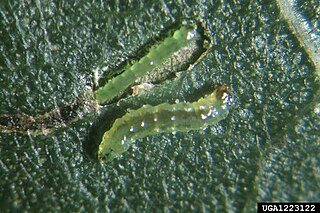
The serpentine leaf miner is the larva of a fly, Liriomyza brassicae, in the family Agromyzidae, the leaf miner flies. It mines wild and cultivated plants, such as cabbage, broccoli, cauliflower and Chinese broccoli.

Agromyza nigripes is a species of fly in the family Agromyzidae. It is found in the Palearctic. The body is black. The thorax and abdomen are shiny. There are 1 + 4 dorsocentral bristles and 7 rows of acrostical bristles. The wing veins are brown, yellow at the base. Long. : 2–3,5 mm. The larva makes serpentine mines in Medicago sativa leaves.
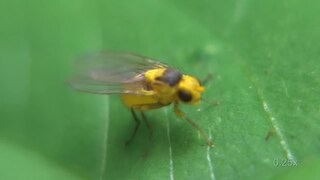
Phytoliriomyza melampyga is a species of fly in the family Agromyzidae. Mesonotum with yellow bands. Scutellum yellow. Frons yellow. The larva mines Himalayan balsam.

Agromyza nana is a species of fly in the family Agromyzidae. It is found in the Palearctic. Description of imago-Interocular space red. Antennomeres 1 and II red. Peristoma and palps black. Dorsocentral bristles : 1 +3 subequal; acrostics in four rows. Legs black, knees red. Abdomen black with lighter pruinosity than the thorax. Long.:1,75-2,5 mm. The larva mines Trifolium pratense, Melilotus altissima, Medicago.

Phytomyza affinis is a species of fly in the family Agromyzidae. It is found in the Palearctic. Description of imago-Antennomere III brown black, 1-11 red. Mesonotum matt black lateral parts and notopleural depression yellow. Acrosticals in 2-4 rows. Coxae 1 yellow basally, II-III blackish. Femora yellow. Base of femora, tibiae and tarsi black. Abdomen brown black. Tergites with a yellow apical line dilated at the sides. Long. : 2,5–3 mm. The larva mines Cirsium arvense and also feeds on seeds of Euphrasia.
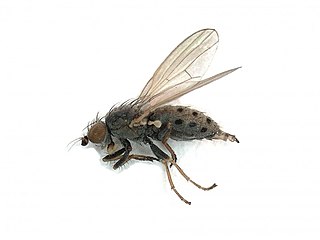
Chamaemyia flavipalpis is a species of fly in the family Chamaemyiidae. It is found in the Palearctic. and North Africa.
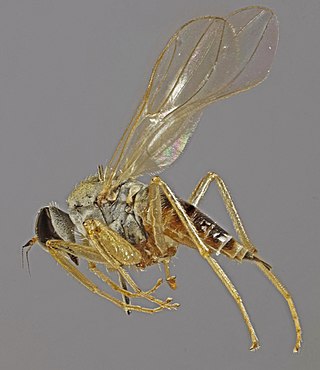
Platypalpus candicans is a species of fly in the family Hybotidae. It is found in the Palearctic.
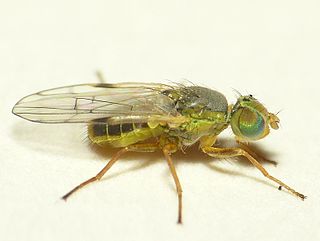
Ensina sonchi is a species of fly in the family Tephritidae, the gall flies. It is found in the Palearctic . The head is light yellow head. Greenish body with yellow villae. The disc of the mesonotum is blackish. Black mesophragm. The legs and halteres are dirty yellow. Wings vitreous or opaline. Abdomen black: tergites tightly yellow at posterior margin with black villi; rufous sternites; Macrochaetes yellowish. Oviscapte black, apex and sides rufous, with fine, yellowish villi. -Long. : 3-3.5 mm. The larvae feed on the flower heads of Asteraceae.

Phytomyza ranunculi is a species of fly in the family Agromyzidae. It is found in the Palearctic.
Liriomyza sativae, commonly known as the vegetable leaf miner, is a species of insect, a fly in the family Agromyzidae. The larvae of this fly mine the leaves of a range of vegetables and weeds, but seem to favour plants in the families Cucurbitaceae, Fabaceae and Solanaceae.

Phytoliriomyza is a genus of flies in the family Agromyzidae.
Amauromyza is a genus of flies in the family Agromyzidae.

Phytobia is a genus of flies in the family Agromyzidae, with a worldwide distribution principally in Europe and the Americas.
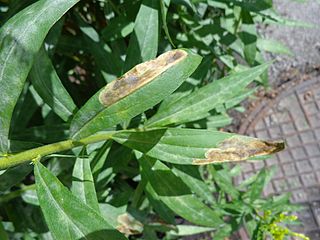
Nemorimyza is a genus of flies in the family Agromyzidae.
Aulagromyza is a genus of flies in the family Agromyzidae.
Metopomyza is a genus of flies in the family Agromyzidae.
Pseudonapomyza is a genus of flies in the family Agromyzidae.
Napomyza elegans is a species of fly in the family Agromyzidae. It is mostly yellow although the top of its thorax and some horizontal stripes on the gaster are black.













